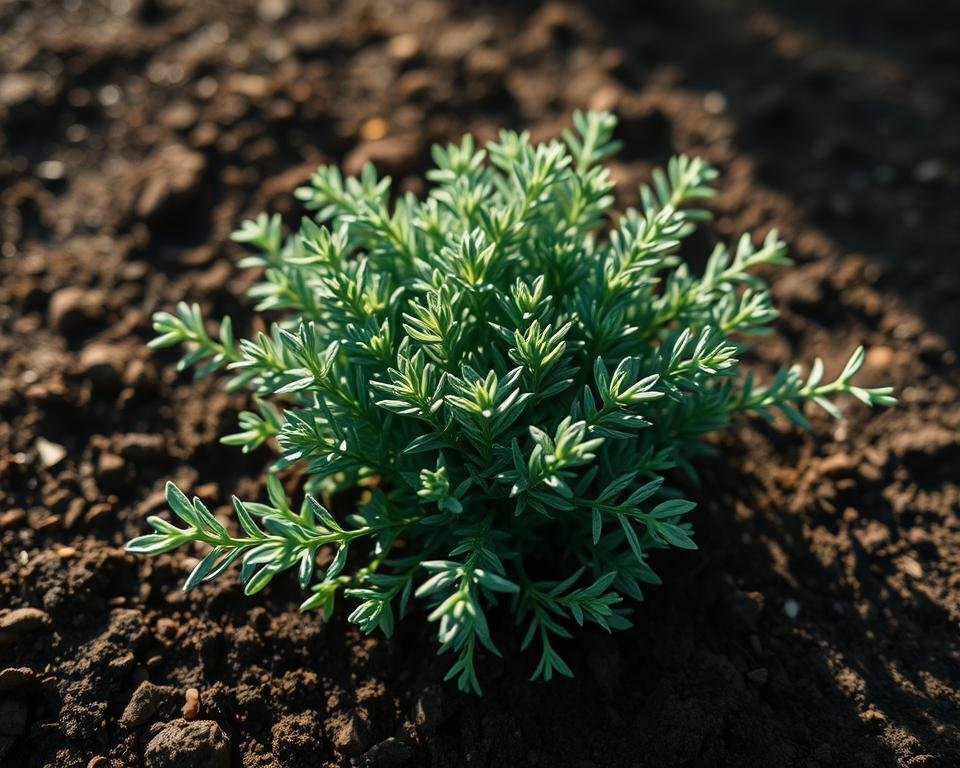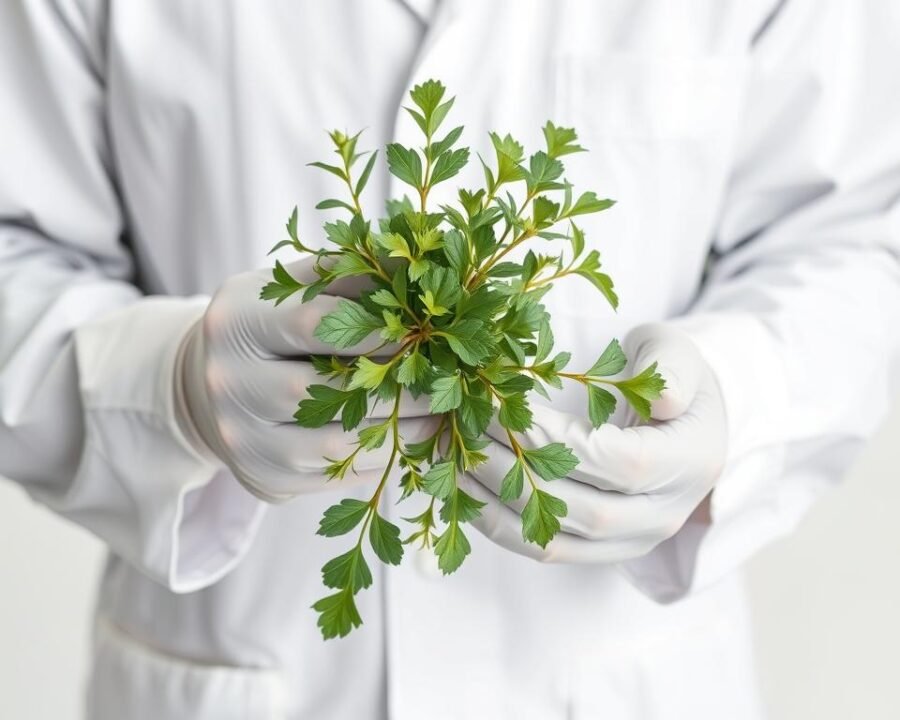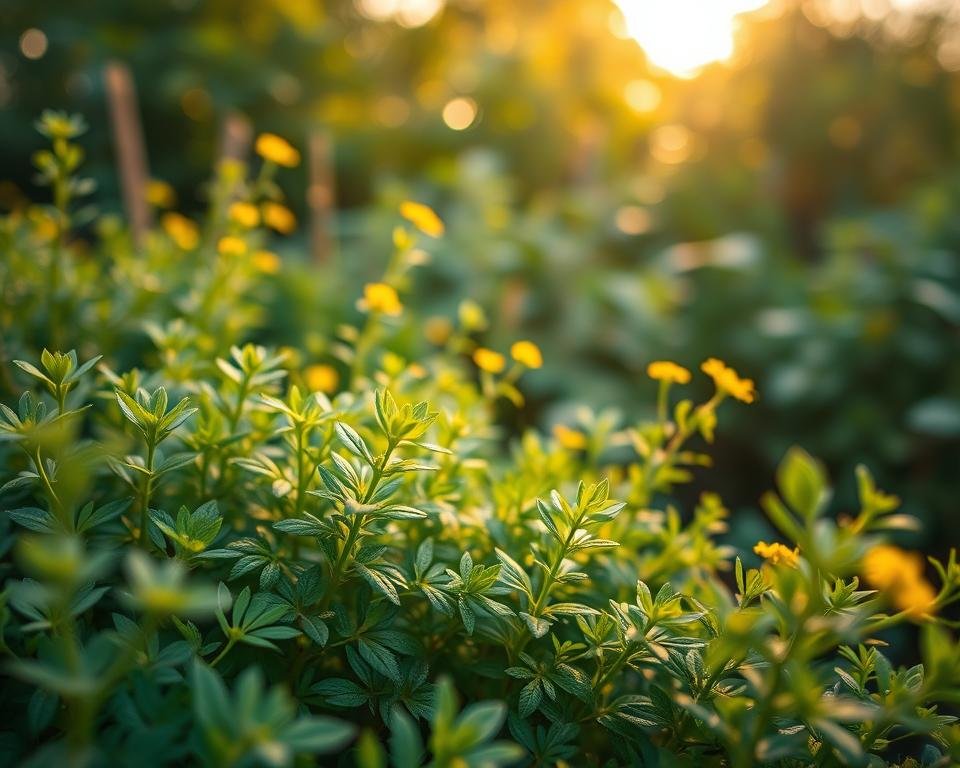There’s something magical about growing plants that carry history in their leaves. Rue, with its blue-green foliage and delicate flowers, has been cherished for centuries—from ancient medicine to modern gardens. Whether admired for its beauty or valued for its uses, this resilient plant offers more than meets the eye.
Beyond its ornamental charm, this hardy perennial thrives in dry conditions, making it a favorite for drought-prone landscapes. Butterflies flock to its blooms, while its leaves add a bold, bitter note to Ethiopian coffee. Yet, its potency requires careful handling—balancing benefits with precautions ensures a rewarding experience.
Key Takeaways
- Rue is a historic herb with ornamental and practical uses.
- It thrives in dry climates and attracts pollinators.
- The leaves can flavor Ethiopian coffee.
- Natural pest-repellent properties make it useful.
- Handle with care due to its strong compounds.
What Is Rue? A Storied Herb with Timeless Appeal
Few plants weave history and utility together like Ruta graveolens. For over 2,000 years, this Mediterranean native flavored feasts, warded off plagues, and even played a role in sacred rituals. Its blue-green leaves carry tales from Roman kitchens to Ethiopian coffee ceremonies.
The Ancient Roots of Rue: From Rome to Ethiopia
Romans treasured rue’s bitter punch. They mixed it into garlic-cheese pastes to balance rich dishes. Historians note its use as a strewing herb, believed to purify air during epidemics.
In Ethiopia, rue’s legacy thrives. During coffee ceremonies, hosts add crushed leaves or seeds to the brew.
“The aroma opens conversations—bitter, but unforgettable,”
shares a local tradition-keeper.
| Era | Use | Significance |
|---|---|---|
| Ancient Rome | Culinary spice | Balanced fatty dishes |
| Middle Ages | Plague prevention | Strewed on floors |
| Modern Ethiopia | Coffee additive | Cultural ritual |
Why Rue Earned the Name “Herb of Grace”
The Catholic Church tied rue to blessings. Priests dipped its branches in holy water, sprinkling congregations. This practice birthed the nickname herb of grace—a nod to spiritual cleansing.
Greek roots add depth. Ruta means “to set free,” reflecting its historic role in purification. Today, it’s a niche ingredient in Old World recipes, bridging past and present.
How to Grow Rue: A Hardy Addition to Your Garden
Rue thrives where other plants struggle, making it a standout for low-maintenance landscapes. Its blue-green leaves and yellow flowers flourish with little intervention, perfect for busy gardeners or arid climates.
Choosing the Right Soil and Sunlight
This plant prefers poor, well-draining soil with a pH of 6.0–7.0. Lime-rich or rocky ground mimics its Mediterranean roots. Avoid heavy clay—root rot lurks where water pools.
Full sun is non-negotiable. Rue demands 6–7 hours of direct light daily. In hotter zones, afternoon shade prevents leaf scorch.

Planting Rue: Seeds vs. Cuttings
Propagation offers two paths:
- Seeds: Sow indoors 6–8 weeks before frost ends. Germination takes 2–3 weeks. Transplant seedlings after frost risk passes, spacing them 30cm apart.
- Cuttings: Snip 10cm stems in spring. Dip in rooting hormone and plant in sandy mix. Success rates exceed 70% with consistent moisture.
| Method | Time to Maturity | Best For |
|---|---|---|
| Seeds | 1 year | Large plantings |
| Cuttings | 6 months | Quick establishment |
Watering and Winter Care Tips
Rue’s drought tolerance means water sparingly. Soak deeply every 2–3 weeks—overwatering invites disease. Containers dry faster; check soil weekly.
In zones below 6, mulch roots with straw before winter. Potted plants need shelter indoors. Skip nitrogen-rich fertilizers; they weaken plant resilience.
Creative Ways to Use the Best Garden Rue Herb You Need to Try
From Ethiopian coffee to Italian sauces, rue adds a distinctive twist. Its bold flavor and pest-repelling power make it a multitasking marvel. Whether in kitchens or gardens, this herb delivers surprises.
Ethiopian Coffee and Culinary Surprises
In Ethiopia, rue elevates coffee ceremonies. Fresh leaves (2–3 per pot) infuse the brew with a bitter, aromatic edge. Locals say it opens conversations—like the drink itself.

Balance the bitterness with acids. Lemon zest or tomato-based sauces tame its intensity. Try it in marinades for a Mediterranean kick.
Rue in Traditional Italian Recipes
Italy’s herbs often include rue. One classic dish, Ruta e Uova, blends chopped leaves into eggs. The result? A fragrant omelet with historic roots.
Pair it with basil or marjoram in tomato sauces. A pinch goes far—its potent taste can overpower delicate flavors.
Natural Pest Repellent and Garden Companion
Rue’s scent deters rats and cats. Plant it near roses or raspberries to shield them from insects. Japanese beetles steer clear.
- Dry leaves for pantry sachets to repel moths.
- Crush fresh sprigs to discourage aphids.
Note: Wear gloves when handling. Its oils may irritate skin.
Handling Rue Safely: What You Need to Know
Safety comes first when working with potent botanicals like rue. Its oils contain compounds that can cause *phototoxic reactions*—especially in sunlight. A grower with 25 years of experience reported only one irritation incident, but precautions are non-negotiable.

Preventing Skin Irritation and Contact Dermatitis
*Wear gloves* and long sleeves when pruning or harvesting. Hot, humid *days* height the risk of *contact* dermatitis. If oils touch *skin*, rinse immediately with cold water.
For accidental exposure:
- Apply a cold compress to reduce swelling.
- Use hydrocortisone cream for mild rashes.
- Avoid sunlight for 48 hours to prevent burns.
Who Should Avoid Using Rue Internally
*Internal* use carries higher risks. Vulnerable groups include:
| Group | Risk | Recommendation |
|---|---|---|
| *Pregnant* women | Uterine stimulation | Absolute avoidance |
| Children under 12 | Liver sensitivity | Consult pediatrician |
| Blood thinner users | Interaction risk | Medical supervision |
The USDA classifies rue as “generally recognized as safe” for topical use but advises against unregulated ingestion. Always consult a herbalist or doctor before *using rue* medicinally.
Conclusion: Embrace Rue’s Unique Charm
A living heirloom, rue bridges ancient rituals and modern gardens. Its silver-blue leaves whisper stories of Roman feasts and Ethiopian coffee ceremonies, while attracting butterflies like the black swallowtail.
Pair it with lavender or artemisia for striking contrast. Start with one plant to gauge your space and skin sensitivity—its herb of grace legacy deserves cautious admiration.
Share your experiments with this historic gem. Whether dried for sachets or grown as a pollinator magnet, rue thrives with mindful care. Let it weave its bold magic into your home landscape.
